Is this a lens? Lens modeling could give you a clue...
-
 by
Capella05
moderator
by
Capella05
moderator
What is Lens Modelling?
A lens model is essentially a sim that mimics an observed lens or candidate
(in other words; you get to create your own sim - but we can't promise they
will look as impressive as Anupreeta's 😃 ). By using a lens modeller and an
image from Spacewarps, it is possible to try and work out the weight of a
galaxy and how the background source would have looked without the lens.What does that mean? Well, if we know the mass distribution of a galaxy we
can work out the distance from the galactic core that we could expect to
see lensed images. If the background source is a quasar, it will produce
point-like images, if it is another galaxy it will produce arcs, perhaps
an Einstein ring.A very simple example of a lens modeller is LensToy
http://slowe.github.io/LensToy/: the mass distribution
is fixed, while the source is a blob you can move around with a mouse.
Other modellers include LensA (not yet online) by @Gumbosea,
MOWGLI http://ephysics.org/mowgli/ and SpaghettiLens, used below.What do we hope to discover by modelling lenses? and why is it so important?
Once a lens candidate is identified, follow-up work typically
involves modelling the lens. If there's a simple model that looks
very like the observed object, it suggests the candidate is indeed
a lens. Conversely, non-lenses often give themselves away by
being difficult to simulate. A lens model may make predictions
from a candidate: for example, it may say that a blob will resolve
itself into two blobs at higher resolution.Assuming the lens is genuine, a lens model tells us how much mass
there is in the lens, and how it's distributed. This is an
excellent way of mapping dark matter.What will happen after I model a suspected Lens? Will a Scientist look at it?
I think I can safely say - Yes 😃 Just remember to post a screenshot of your model, the link to the results page and the ID of the image.
How do I get started?
At the moment we are running google+ hangouts, where you can get a basic tutorial on how to use SpaghettiLens, and a run down on how to interpret the results.
This is still very new (to me at least!) and I am planning on writing a simple step-by-step tutorial when I get to grips with the program.
In the meantime If you would like to get involved, just post in this thread 😃
Posted
-
 by
Capella05
moderator
by
Capella05
moderator
ASW0003bit originally posted by @ElisabethB, known lens candidate SA28.
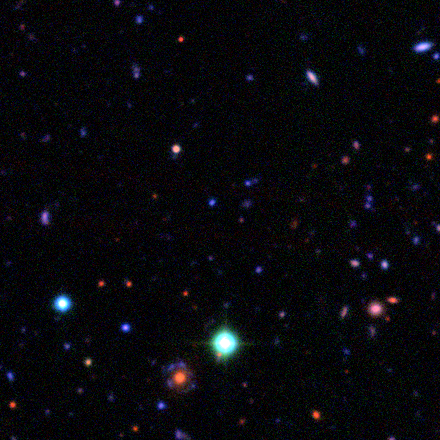

ASW0003bit results
Posted
-
 by
Capella05
moderator
by
Capella05
moderator
ASW0000x1l, originally posted by @drphilmarshall.
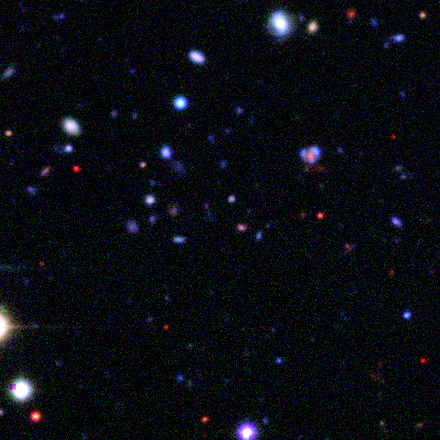

ASW0000x1l results
Posted
-
 by
Capella05
moderator
by
Capella05
moderator
ASW0001e2j, originally identified by @ElisabetbB, ID by @ceperman - known lens candidate SA6
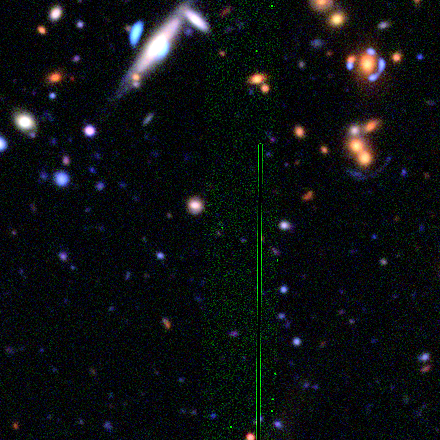

ASW0001e2j results
Posted
-
 by
anupreeta
scientist, admin
in response to Capella05's comment.
by
anupreeta
scientist, admin
in response to Capella05's comment.
A known lens candidate ( SA28 - http://kicp.uchicago.edu/~anupreeta/sarcs_sample). Its a very promising one.
Posted
-
 by
Capella05
moderator
in response to anupreeta's comment.
by
Capella05
moderator
in response to anupreeta's comment.
Yes, I know 😃
I was getting the master class on lens modeling, so we thought we would try known ones vs unknown ones, and compare the results 😄
Posted
-
 by
Capella05
moderator
by
Capella05
moderator
@psaha just pointed out I had inadvertently switched 2 images - corrected - hopefully 😕 😃
Posted
-
 by
Tom_Collett
scientist
in response to Capella05's comment.
by
Tom_Collett
scientist
in response to Capella05's comment.
In that lens, the white light is not part of the lensed source (it's a different color), so you don't need to have a counter-image where the white light is. Because there is no counter-image visible, you will be able to make many plausible models. Counter-images really help in constraining the models. Often the counter-images are faint, so we have to get deeper follow up imaging to find them.
Posted
-
 by
Capella05
moderator
in response to Tom Collett's comment.
by
Capella05
moderator
in response to Tom Collett's comment.
In the last image?
Posted
-
 by
Tom_Collett
scientist
in response to Capella05's comment.
by
Tom_Collett
scientist
in response to Capella05's comment.
Yes, ASW0001e2j. (Sorry I wasn't clearer)
Posted
-
 by
psaha
scientist
by
psaha
scientist
Yes, the model of ASW0001e2j is predicting a counter-image at 11 o'clock, but as @Tom_Collett points out, it can't be the white blob. There could conceivably be a faint blue image drowned out by the white blob ... or this could be a #modelfail 😃
The models of ASW0003bit and ASW0000x1l model look more convincing.
Posted
-
 by
Capella05
moderator
by
Capella05
moderator
ASW0000v4y orignally posted by @tashipoo, identified as a possible candidate by @Tom_Collett
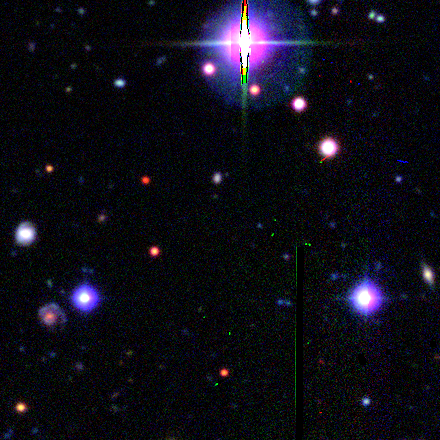

Very simplistic - I know 😃 I was thinking about adding an additional saddle and 2 minima in the top lens at 10 and 3? Do you think this will make a difference?
Posted
-
 by
psaha
scientist
in response to Capella05's comment.
by
psaha
scientist
in response to Capella05's comment.
The pixellated model arc definitely looks like it's on the right track. Nice candidate, and after this model ASW0000v4y can hardly wriggle out of being a lens!
Your idea of making the green minimum into a saddle with two new minima sounds good. It may reproduce the slight breaks in the arc at 11 and 2 o'clock.
Posted
-
 by
Capella05
moderator
in response to psaha's comment.
by
Capella05
moderator
in response to psaha's comment.
Excellent - I will try re-modelling the image tomorrow 😃
Posted
-
 by
Capella05
moderator
by
Capella05
moderator
Second Attempt at ASW0000v4y - unfortunately I was unable to save the result, but managed to grab a screenshot of the pixellated model arc.


The extra saddle seems too of worked - we have breaks in the lens at 2 and 11:30 - I just might want to adjust them slightly when the server is back up.
Posted
-
 by
psaha
scientist
in response to Capella05's comment.
by
psaha
scientist
in response to Capella05's comment.
Yes, the extra saddle clearly improves the model. (Also shows that SpaghettiLens should try and use smaller pixels for the arc sim!)
Posted
-
 by
Capella05
moderator
by
Capella05
moderator
Final version of ASW0000v4y.


Posted
-
 by
Capella05
moderator
by
Capella05
moderator
ASW00056pq posted and identified by @C_cld (SA63)
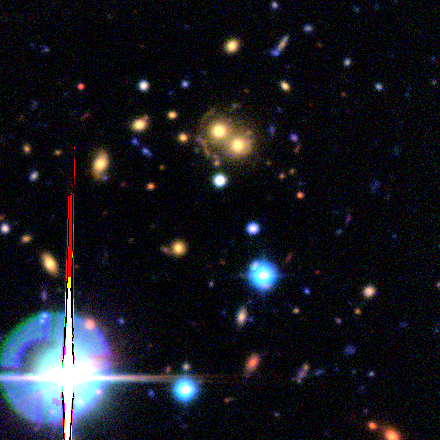
In this model we were trying to see if we could use SpaghettiLens to model a cluster. Model suggested a counter image at 4 o'clock. Not visible.


We thought we could be a bit more adventorous...

Unable to generate a viable model.
Posted
-
 by
Capella05
moderator
by
Capella05
moderator
ASW000234o posted by @Damon22
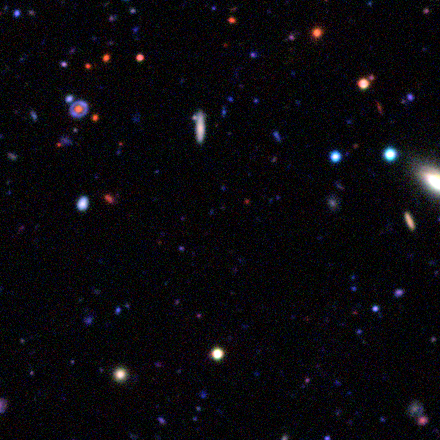


Results Quite convincing if we ignore the spikes in the ring.
Posted
-
 by
Capella05
moderator
by
Capella05
moderator
ASW0003q47 posted by @Capella05
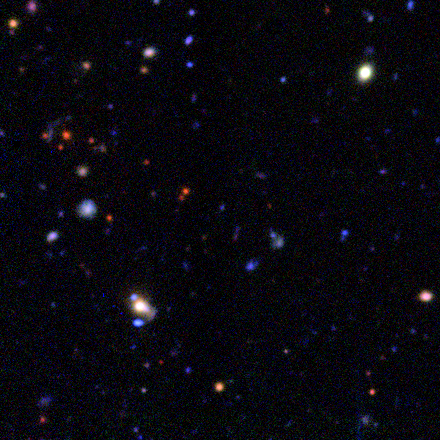


Unable to generate a viable model.
Posted
-
 by
psaha
scientist
in response to Capella05's comment.
by
psaha
scientist
in response to Capella05's comment.
The identification of max/min/saddle looks very plausible, but SpaghettiLens doesn't have this case implemented as yet.
Posted
-
 by
Capella05
moderator
by
Capella05
moderator
ASW0000004 posted by @Elizabeth
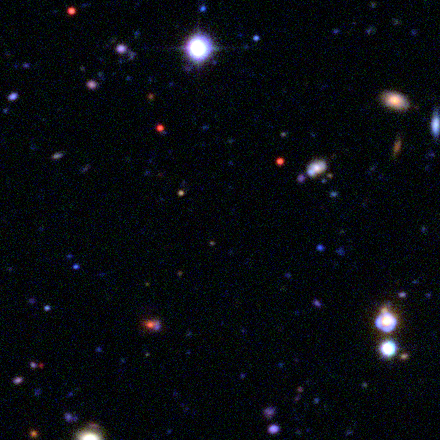


Overall I am quite happy with the result, the upper left will need tweaking...
Posted
-
 by
psaha
scientist
in response to Capella05's comment.
by
psaha
scientist
in response to Capella05's comment.
A very interesting system: looks like a near-complete ring, with slight breaks at 11 and 2 o'clock.
Maybe a model would two minima and two saddles would work better? Could be either
- saddles at 12 and 6 o'clock, and minima at 3 and 9, or
- saddles at 3 and 9 o'clock, and minima at 12 and 6.
Possible a point mass at the orange blob.
Posted
-
 by
Capella05
moderator
by
Capella05
moderator
ASW0000004 revisited.
As suggested by @psaha I have introduced an additional saddle and minima at the bottom (as per point 1) and a mass point at 11.
In the resulting pixel model, I am not so sure about the vertical line extending from 12. We now have breaks at 2 and 11.


Posted
-
 by
psaha
scientist
in response to Capella05's comment.
by
psaha
scientist
in response to Capella05's comment.
The model from the spaghetti smiley looks very plausible. The vertical line in the coarse synthetic image is a radial arc, except that the model has made it very prominent.
In SpaghettiLens, arcs tend to be features running from a saddle to a nearby minimum or maximum. Spaghetti curves tend to go through breaks in arcs, as they do at 11 and 2 o'clock in this model.
Posted
-
 by
Capella05
moderator
by
Capella05
moderator
ASW0002k40 version 1 - without a mass point

![enter image description here]
(http://i1203.photobucket.com/albums/bb397/capella05/Lens modelling/ASW0002k40pixelmodelv1_zps61d97dd7.jpg?t=1371143714)Posted
-
 by
Capella05
moderator
by
Capella05
moderator
ASW0002k40 version 2 - with a mass point. The pixel result models are quite similar.


Posted
-
 by
Capella05
moderator
by
Capella05
moderator
ASW00001tr - This is the last of several models of this object. Not very convincing.


Posted